Home of the Infantry Regiments of Berkshire and Wiltshire
The Militia, Volunteers and Territorial Army
Origins
Even in times before the Vikings every young man was expected to play his part in the defence of his home. The arrival of the Romans and their professional army saw this need rapidly disappear but with their withdrawal in 410 AD the citizens were faced with the age old problem of defence without a professional army. Instead of forming their own citizens army they relied on mercenaries, often recruited from the ranks of their potential enemies.
Until the arrival of William the Conqueror the need to bear arms to defend ones homes and to serve the interest of the King remained very ad hoc. William made sure that each new landowner had his lands scattered around the country. The formal groupings for military and security purposes were based on families. Ten families were grouped into “tythings”, ten tythings formed a “Hundred” and these Hundreds formed the building blocks of the County, with a Duke or Earl having overall responsibility. Thus when the King called for men to serve in one of his campaigns he did so by placing the requirement on one or more of his Hundreds, who in turn passed it down to parish level. The military force that was called out in this way was the “Fyrd”, these arrangements were formalised in statures in 1285 and remained in force until 1553.
In Elizabeth I reign there were several general musters in anticipation of invasion from Spain. In 1614 another general muster was called when it became obvious that the general state of competence left a lot to be desired. The several county contingents were sent home and told to model their arrangements on the 'trained bands' recently introduced to London.
The English Civil War saw the Royalist and Parliamentarians raise their own forces to fight each other. When the civil war ended the two sides were merged and the militias placed under 'commissioners'. On being restored to the throne, King Charles II Charles II set about forming a professional army with the militias as his reserves. They were put back under the Lords Lieutenants of the Counties and ordered to hold a County muster once a year with each company assembling for training four times a year.
The Berkshire Militia
The Militia were called out in the Dutch Wars and in 1666 Berkshire sent three companies of 'lusty, well armed' men for the defence of the south coast. 300 men from the Berkshire Regiment of Militia under Major Peacock were based at West Cowes. They were dismissed 27th July 1667 when their commander was Lt Col Saunders.
The next major callout was in 1685 when there was a general muster to deal with the Monmouth rebellion but the next few years were relatively quiet.
The militias were re-embodied in 1715 in response to the Jacobite rebellion. On the 25th October the Lord Lieutenant of Berkshire, the Duke of St Albans, was ordered to bring the militia up to full strength and efficiency. Each parish in the county was ordered to find a number of soldiers according to their population. By now the standing professional army was well established but there was some unease as so many of the members were mercenaries, mainly Hanoverian.
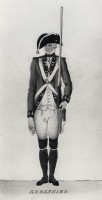
A soldier of the Militia in 1780
In 1756 the forces were once more reorganized and the militias were now aligned with their county line regiments. The next year on July 25th 1757 the Berkshire Militia was embodied with an establishment of 560 men under the Duke of St Albans. Wokingham, although in Wiltshire, was ordered to contribute to the Berkshire force. There were two divisions, one for Hungerford and Illsley and one for Newbury and Speen. Reading contributed five companies with Wallingford and Wokingham contributing two each. There was a rule that if any man fell out through sickness or other cause then he had to be replaced by the parish in which the fallout occurred with the parish officers being reimbursed.
The subsequent period from 1757 to 1815 was one in which war was the norm rather than the exception. Service in the militia was compulsory with a term of service of three years. At any given point in time the militia could be 'embodied' or 'disembodied' The status of embodiment required residence in a camp or barracks and although restricted to service in the United Kingdom, they were otherwise treated very much as regular infantry. When disembodied however only attendance at the annual camp was required and quite often this was not even called.
The Regiment had been embodied:
- In the Dutch Wars 1666.
- In the Monmouth Rebellion 1685.
- In the Jacobite Rebellion 1715.
- In the Seven Years War 1757 – 1762.
- In the American War of Independence 1778 – 1783.
- In the French Revolution 1792 – 1802.
- In the Napoleonic Wars 1803 – 1816.
- In The Crimea War 1856.
- In The Indian Mutiny 1857.
- In the South African War 1900 – 1902.
The 3rd (Special Reserve) Battalion
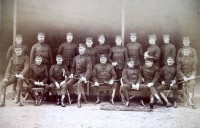
The Officers at Reading in 1887
Under the Haldane reforms which saw the introduction of the 4th Battalion as the Territorial Force, the 3rd Battalion lost all its connections to the Militia and became the Special Reserve Battalion. The main changes were that new recruits to the regiment came to the 3rd for six months initial training and regular officers from the Depot came to join the annual camp which was reduced from 28 to 21 days.
As an incentive men had to demonstrate their proficiency at the butts and could then receive proficiency pay.
Lt Col Barker took over command in 1909.
Annual training took place at Salisbury Plain (1910), Felixstowe (1911), Churn Camp (1912) and Perham Down (1913). Their last ever annual training took place at Felixstowe at Landguard Fort in May 1914
The Berkshire Volunteers
Although volunteers had been raised in Berkshire there is no real link with the units formed in 1859. Berkshire was well placed because of the influence and enthusiasm of Colonel Lloyd Lindsay VC, who had gained his Victoria Cross in the Crimean War. By 1860 the rules had been laid down and the units formed. The first Volunteer review took place in Hyde Park in June 1860 in the presence of Queen Victoria. In 1861 there were companies in Reading, Windsor (2), Newbury, Abingdon, Faringdon, Wantage, Wallingford, Windsor Great Park, Winkfield, Sandhurst and Woodside. In May 1863 the uniform was defiantly laid down to consist of a dark grey tunic and cap, trimmed with cord of the regimental colour. An Inverness-pattern cloak, black gaiters and black haversack completed the simple outfit which was all that could be afforded when the uniform had to be paid for by the corps itself, without government financial aid. In 1873 the Administrative Battalion became the 1st Berkshire Volunteer Corps, consisting of 13 companies viz….
Reading (A, B & C Companies); Windsor (D); Newbury (E); Abingdon (F); Maidenhead (G); Sandhurst (H); Faringdon (I); Wantage (K); Winkfield(L); Wallingford (M); Windsor Great Park (N)
In 1881 after the Cardwell reforms the battalion became the 1st Volunteer Battalion, Princess Charlotte of Wales’s (Berkshire) Regiment, thus cementing a link with the regular units of the Regiment.
During the Boer War the Battalion supplied a company to the 2nd Battalion in South Africa.
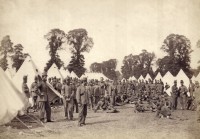
Berkshire Volunteers Rifle Volunteers - Kit inspection by Colonel Lindsay VC at Crookham Camp near Marlow in 1863
In 1908 the Volunteers disappeared under that title as a result of the Haldane reforms becoming the 4th Battalion (Princess Charlotte of Wales’s) Royal Berkshire Regiment. On the outbreak of the First World War the Battalion expanded and formed two front line battalions, the 1st/4th and the 2nd/4th. These were supported by a 3rd/4th. The 1st/4th went to the Western Front in early 1915 fighting in many major battles. In 1917 they were transferred to the Italian front where they continued fighting until the Armistice. The 2nd/4th went to France in early 1916 taking part in all the major engagements that followed. They remained in this theatre until the end of the war. After the War both battalions were disbanded and a new 4th Battalion reformed. Between the wars the 4th Battalion maintained its strength attending annual camps each year.
In 1937 it was decided that many of the London Regiments would be designated and linked to line Regiments. As a result the 10th London Regiment (Hackney) became the 5th (Hackney) Battalion Royal Berkshire Regiment. In 1939 all the territorial Regiment were expanded to meet the threat posed by Hitler. The 4th Battalion expanded forming the 6thBattalion and the 5th formed the 7th Battalion. On the outbreak of war the 4th Battalion were sent to France as part of the BEF. They confronted the German Blitzkrieg, but with the remainder of the British Army retreated to the beaches of Dunkirk. They came of the beaches only 40 strong, in effect the battalion was wiped out. The battalion spent the rest of the war as an Officer training unit. The 6th and 7th Battalions remained in England and Northern Ireland engaged in Home defence duties and supplying men to the other front line battalions. The 5th Battalion was trained up to take part in the Normandy landings as a beach battalion. In this task they required all the skills of a normal infantry battalion plus more to establish and hold a bridgehead. With various attachments the Battalion on the 6th June 1944 was 2000 strong. They landed on Juno beach in support of the Canadians. After this the Battalion was split up supplying men to other infantry units, many going to the 4th and 5th Wiltshire Regiments. The Battalion was reformed for the crossing of the Rhine where the skills gained on the Normandy beach was put to good use. At the end of the war they were disbanded and later re-formed as a Royal Artillery unit.
After the war the 4th Battalion were reformed as the 4th/6th Battalion and remained as such until 1967 when they became part of the Wessex Regiment.
The Wiltshire Militia
In 1757 a new militia act placed the responsibility of providing men on the counties, instead of on their individual landowners. The County quota was apportioned amongst its parishes, who had to provide so many men each, between the ages of eighteen and forty five under the penalty of fines. Service was restricted to Great Britain, and the treasurer found arms clothing and pay during training or embodiment.
For most of the next sixty years England was at war with France or America and from 1759 to 1816 the Wiltshire Militia were embodied for nearly two thirds of the time, serving in many places in England Scotland and Ireland.
In 1759, after a dispute between militia regiments over seniority, regimental numbers were decided by lot, and the Wiltshire militia became the 33rd. They were now ten companies strong in one regiment only, whose headquarters were at Bedwyn, Devizes, Salisbury, Swindon, Warminster, Hindon, Bradford, Wilton, Chippenham and Malmesbury. The following year they were guarding French Prisoners of War I building intended as a Palace for Charles 11 at Winchester, and which later became the Green Jackets Depot
In 1814 the Wiltshire Militia volunteered for Foreign Service, and 4 officers and 130 other ranks embarked as part of the 2nd Battalion of the Militia Brigade which landed at Bordeaux to serve under Wellington.
They were given the title ‘Royal in June 1841 but gave it up in 1881, when amalgamated with the Regular Battalion as the 3rd (Militia) Battalion of the Duke of Edinburgh’s (Wiltshire Regiment). Apparently there was no regular training prior to 1854, as when embodied in that year they had no uniforms, arms or equipment, and non-commissioned officers were lent by the Guards to assist in their training, . During their embodiment they first garrisoned Portsmouth, and then in 1855, having volunteered for Foreign Service, they sailed to Corfu, and their colours carried the word ‘Mediterranean’ in memory of this service.
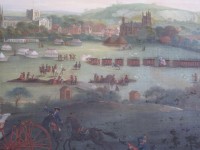
Royal Wiltshire Militia being inspected on Annual Camp at Winchester.
The Regiment had been embodied –
- In the Civil Wars of Charles I
- In the Seven Years War (From June 1759, to December, 1762)
- In the Napoleonic War (1813 – 1814)
- In the Crimean War (from June 1854, to September 1856)
- During the Indian Mutiny (from October 1857 to April 1860)
- In the South African War (from January, 1900 to September, 1902)
- In the Great War (from August, 1914 to October, 1919)
During the South African War the Battalion volunteered for foreign service, and, after service at Cork, were sent to St Helena in 1901 as garrison and guard to Boer prisoners, and ‘St Helena’ appears as a second honour on their colours. In 1908 the title ‘Militia’ was abandoned, and the Battalion became the 3rd (Special reserve) Battalion of the Duke of Edinburgh’s (Wiltshire Regiment). The colours carried from 1913 onwards were presented by Field Marshal Lord Methuen at a parade at Devizes, and on them appear the battle honours of the Regular Battalions, and not those of the Militia. The Battalion was mobilized on the 8th August 1914 and proceeded to Weymouth. Their duty there was to protect Portland Harbour from attack, and to assist locally in training the influx of volunteers. They moved to Lodmore in early 1915 remaining there until 1917 when they were moved to Sittingbourne on the East Coast, and then to Maidstone. The Battalion in addition to furnishing drafts for the units of the Regiment on active service also provided a home for the wounded. During the war they dispatched 622 officers and 13,486 other ranks to join the various battalions overseas. In March 1919, after the Armistice, the Battalion was ordered to Dublin where, it was stationed for eight months until relieved by the 1st Battalion, and was finally disembodied in October, 1919.
1st Volunteer Battalion Wiltshire Regiment.
This Battalion was raised in the early days of the First World War for purposes of home defence, and was composed largely of men who were too old or to young for more active service, or not up to the physical standard required. 2000 men were trained by the Battalion, which reached a high state of efficiency, and 600 men were passed on to the Regular Army. This unit is not to be confused with the early volunteer units, and were the forerunners of the 2nd World War Home Guard
The Wiltshire Volunteers
After the French Revolution at the end of the eighteenth century, Great Britain was faced with a possible invasion. From this threat grew the military Volunteer Movement. Loyal Associations were organised in towns for their local defence about 1798. This remained until the formation of the volunteers on a wider scale in 1859. In 1802 the West Wilts Volunteers were formed remaining until 1808 when they were disbanded and absorbed into the Local Militia. In 1959, after the Indian Mutiny had broken out, Local Volunteers Corps were re-introduced in Counties, this time on a no cost basis. The proposed uniform was described as a “Dark grey, coat to be loose frock, single breasted with narrow stand up collar and a little cut in at the waist with a black cord on each shoulder and a black braided half an inch wide at the top and bottom of the collar. The trousers to be of the same colour as the coat with a black braid stripe half and inch on the outside. The headdress to be a cap of the same colour as the uniform with a black band and a bronze bugle in front of similar shape and height to the pattern produced, and to be provided with an oil skin cover to be worn in wet weather”.
The 6th (Maiden Bradley) Corps was a much more unorthodox body. It consisted of tenants of the Duke of Somerset, and was raised and commanded by the Earl St. Maur, who modelled it on the irregular cavalry of India. Drilling and hunting were combined, as most of the members lived on farms in the Blackmore Vale Country, while at Warminster were the kennels of the South Wilts of whom their Lieutenant Colonel was the master.
In 1860 the volunteer units were formed into two Battalions of Rifle Volunteers, each 1000 strong. The 1st covered the Southern half of the county with its headquarters at Salisbury, and included Wilton, Warminster, Westbury, Trowbridge and Bradford on Avon. The Northern half embraced the 2nd Battalion and included Devizes, Market Lavington, Chippenham, Calne, and Swindon. In the Cardwell reforms of 1881 the volunteer units were incorporated into the Regimental District. Before being organised into battalions the uniforms of the volunteer corps were bright varied and original. The Wiltshire uniforms were based on “Rifle green and black and remained so right up to 1914. The original uniform of the 1st Battalion was dark green with black lace, similar to that of the rifle brigade. The original Badge was two rakes crossed, with, in the centre, the historic barrel and moon of the Moonraker legend. It was consider merging the two battalions at this stage but no action was taken to facilitate this for twenty two years. About 1889 the 1st and 2nd Battalions, Wiltshire Rifle Volunteers, were renamed respectively the 1st Wiltshire Volunteer Rifle Corps, and the 2nd Volunteer Battalion the Wiltshire Regiment. In 1900, during the Boer War, a volunteer Company was recruited from the two volunteer Battalions as reinforcement to the 2nd Battalion on active service in South Africa. The company was commanded by Viscount Folkestone, joining the Regiment in Bloemfontein in April 1900, and returned home at the completion of its year of service, having seen much active service, and having proved itself in all respects up to the standards of regular troops.
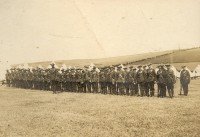
1st Wiltshire Rifle Volunteers - A Group of Volunteers on parade on Salisbury Plain, prior to going to South Africa in 1900
In 1908 both Battalions were merged into the 4th (Duke of Edinburgh’s) Wiltshire Regiment as a result of the Haldene reforms. As a result of this merger twenty two companies had to be compressed into eight, a drastic and difficult business. The company locations became, Malmesbury, Devizes, Swindon, Salisbury, Trowbridge (HQ), Bradford-on-Avon, Warminster and Wilton.
On the 4th August 1914 the Battalion was at its annual camp at Bulford, where they mobilized. They immediately went to Salisbury where they were 50% over strength, which resulted in them being sub divided forming the 2nd/4th Battalion. Both battalions went to India where the 2nd/4th remained throughout. The 1st/4th went to Palestine in 1917 where they saw some hard fighting. After the war both battalions were demobilized and a new 4th Battalion reformed. In 1925 the Battalion as officially recognised as a battalion of the line, although it had ceased to have a ‘Rifle Battalion’ connection back in 1908.
In 1939 the Battalion was again expanded on the outbreak of the 2nd World War, although this time the new battalion was numbered as the 5th Battalion. After ‘D’ Day both battalions fought their way across North West Europe and into Germany winning a number of battle honours in the process. After the war both Battalions were disbanded and a new 4th Battalion re-formed in 1947. The Battalion remained under this title until 1967 when they were initially merged into the Wiltshire Volunteers, and shortly after The Wessex Regiment.
Wessex Regiment
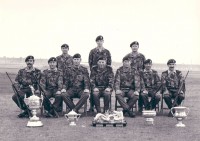
1st Battalion, Wessex Regiment - The Major Units Champions at Bisley in 1980.
In 1967 the Territorial County Battalions of Wiltshire,Royal Berkshire, Gloucestershire, Devon, Dorset and Hampshire were disbanded. They were replaced by the Territorial and Volunteer Reserves (TAVR) and named ‘The Wessex Volunteers’ that subsequently became the 1st Battalion Wessex Regiment.
In 1971 the Government decided to expand the TAVR in order to provide a reserve force specifically for the defence of the UK. 20 additional infantry units were raised, including the 2nd Battalion the Wessex Regiment. The two battalions were very much interlinked with sub units of both battalions being cross posted depending on the latest re-organisation. Most of the permanent staff came from the Regular Wessex Brigade battalions with the Duke of Edinburgh’s Royal Regiment providing a fair share. These battalions were effectively the ‘Territorial ‘arm of the Regiment.
The 1st Battalion with its headquarters at Devizes became a NATO roled unit, and the 2nd Battalion with its headquarters at Reading were deployed as a Home Defence Battalion.
‘E’ Company (Home Service Force)
2nd Battalion Wessex Regiment
Formed in 1985 by the Thatcher Government at the height of the Cold War, the Home Service Force (HSF) bolstered the UK's Home Defence assets. HSF units were primarily tasked to defend Key Points throughout the UK against sabotage from enemy Special Forces.
Initially, three pilot units were formed to test the concept of a home defence force comprising ex-regular, ex-territorial and ex-uniformed service personnel. The results proved to be better than anticipated. The recruitment of ex-servicemen with a minimum of two years experience enabled units to come up to operational readiness very quickly. On completion of a successful trial period authorisation was given for the HSF to be formally embedded. A national recruiting campaign was launched towards the end of 1984 with a view to enlistment commencing on 1st April 1985. Each HSF unit was placed with either a Regular Army or Territorial Army regiment or battalion for administrative purposes and given the units title and cap badge. The Wessex Company with its headquarters at Reading in Brock Barracks was one of the four experimental Home Service Force Companies (officially Home Service Force Company No 2), E (HSF) Company 2 Wessex. They remained as part of the order of battle until 1992 when they were disbanded following the collapse of the Soviet Union and the Warsaw Pact allies and the changed European situation. The Company consisted four platoons, plus a headquarter group.
2nd (Volunteer) Battalion the Royal Gloucestershire, Berkshire and Wiltshire Regiment
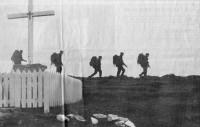
2nd Battalion - A patrol in the Falklands 1996
In 1995 the 2nd Wessex (Territorial) Battalion which had succeeded the 4th/6th Royal Berkshires became the 2nd Battalion of the RGBW. In 1998 they were presented with colours by the Duke of Edinburgh at Windsor Castle
Under Options for change this Battalion was disbanded in 2000 and split between The Royal Rifle Volunteers and the Rifle Volunteers. The former was the Territorial unit for South Eastern England and the latter for South Western England. The Royal Rifle Volunteers was based at Brock Barracks in Reading and formed part of 145 Brigade. The Rifle Volunteers was based in Bristol.
Royal Rifle Volunteers
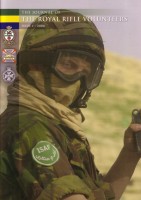
Royal Rifle Volunteers
The regiment was formed on 1 July 1999 by the amalgamation of elements of the 6th/7th (Volunteer) Battalion, The Princess of Wales’s Royal Regiment 2nd (Volunteer) Battalion, The Royal Gloucestershire, Berkshire and Wiltshire Regiment and the 5th (Volunteer) Battalion, The Royal Green Jackets due to the reforms of the Territorial Army implemented following the Strategic Defence Review It was the infantry component of 145 (Home Counties) Brigade. In 2002 the Royal Rifle Volunteers took part in a major NATO “Partnership for Peace” exercise in the Ukraine codenamed Exercise COSSACK EXPRESS. In 2003 they took part in a major NATO exercise in the Eastern European country of Lithuania codenamed Exercise AMBER HOPE. A formed platoon was also deployed to Afghanistan as part of Op FINGAL. Some soldiers from E (RGJ) Coy also deployed to Bize, Albania in support of the Royal Welsh Regiment’s “Partnership for Peace" exercise codenamed ALBANIAN EXPRESS. In 2005 a formed company (Roebuck Company) from the RRV, along with a platoon attachment from the 3rd Battalion Princess of Wales's Royal Regiment was dispatched to Iraq which was part of the Multi-National National Division (South East) as part of Op TELIC.
On 24 November 2005, the MOD announced a reorganisation of the army, and it was planned that the RRV would become the 4th Battalion, Royal Green Jackets. However, at a later date the Light Division decided to amalgamate the Light Infantry and Royal Green Jackets. They were also joined by the Devon and Dorset Light Infantry and the Royal Gloucestershire, Berkshire and Wiltshire Light Infantry merging into five regular and two territorial battalions. The RRV became their 7th Battalion on the 1 February 2007 with its headquarters at Brock Barrack, Reading.
7th Battalion the Rifles
The headquarters of the Battalion is at Brock Barracks, Reading. Since its formation the Battalion has sent a number of its soldiers to Iraq and Afghanistan to support other Rifle Battalions and other units.
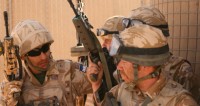
Members of 7th Battalion The Rifles deployed on Operations
